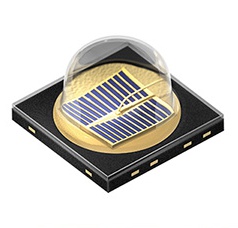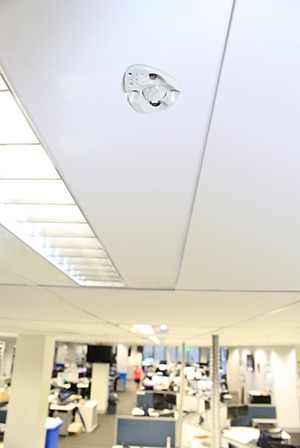 |
| July 25, 2017 | Volume 13 Issue 28 |
Designfax weekly eMagazine
Archives
Partners
Manufacturing Center
Product Spotlight
Modern Applications News
Metalworking Ideas For
Today's Job Shops
Tooling and Production
Strategies for large
metalworking plants
LEDs with sensors act with swarm-like intelligence
Osram infrared LEDs establish line of communication between distributed luminaires.
The Australian company Organic Response has developed technology that allows individual luminaires in large lighting installations to communicate with their immediate neighbors -- just like a school of fish would do. Communication is based on modulated infrared light signals that are emitted by high-power infrared LEDs (the Oslon SFH 4725S line) from Osram Opto Semiconductors.

The high-power infrared LED SFH 4725S enables distributed luminaires to act with "swarm-like" intelligence. [Image: Osram]
Organic Response Lighting Control Systems are designed to operate wide-area lighting installations with maximum energy efficiency while still maintaining a high level of comfort. The key lies in a system of distributed intelligence that enables the system to react to the presence of people in the immediate vicinity of sensors, as well as to those further away.
How it works
Sensor nodes integrated in each luminaire are at the heart of the system. They comprise a motion sensor, an ambient light sensor, and an infrared transmitter/receiver pair used for communication. The moment a sensor node detects occupancy, the luminaire reacts by putting out a predetermined light level. At the same time, it communicates that occupancy status to its neighbors by emitting an infrared signal. Subsequently, the neighboring sensor nodes respond by setting their luminaire to a predetermined light level appropriate to an occupant in that vicinity. They then simultaneously relay another infrared signal to their own neighbors, informing them there is an occupant two light fittings away.
Ultimately, each sensor node "knows" how close a person is and sets the luminaire to an appropriate brightness. In this way, it is not just the spot the person is in that is illuminated, but also adjacent areas. This also eliminates the sensation of literally stepping into darkness when entering currently unoccupied spaces.

Thanks to high-power infrared LEDs from Osram, distributed lighting installations can be operated in an energy-efficient way while maintaining a high level of comfort. [Image: Organic Response]
Using light as a means of communication ensures that only luminaires within the person's field of vision are turned on, while systems in neighboring rooms, for instance, will not be triggered. In case a room or an office is reorganized, newly positioned walls will automatically block the infrared signal and thus adapt the system response automatically to any adjustments.
High-power infrared emitter with short switching times
This solution is designed to address a broad range of applications of different scales, therefore requiring high-power infrared emitters. The infrared light signal must be set in a way that it reaches all of its immediate neighbors but does not affect the units beyond. This operating distance depends first on the strength of the light signal. But it is also affected by ambient light conditions, the height of the ceiling, and the reflectivity of the floor. As such, signal strength must be adjusted individually according to environmental and structural conditions. In contrast to lighting installations that require IDs assigned to each luminaire (and which therefore need to be programmed), the organic response solution uses the adjustable range of the IR signal to address specific luminaires, eliminating the need for programming during installation.
The infrared (IR) LED Oslon SFH 4725S provides enough optical power to ensure communication for all possible setups. The IR LED is based on stack technology, which was developed by Osram to provide one chip with two emission centers, thereby doubling its output. Driven at 1 amp, the SFH 4725S yields 990 milliwatts (mW) of optical power. Its narrow emission angle of +/-45° results in a radiant intensity of 425 mW/sr. The emitted light has a wavelength of 940 nanometers, which is completely invisible to human eyes but a perfect match for the spectral sensitivity of silicon photodetectors. The SFH 4725S features short rise and fall times of 10 and 15 nanoseconds, respectively, and thus permits modulated light signals.
"We initially designed this emitter for infrared illumination and 3D camera applications. But with its high power, narrow emission angle, and fast switching time, it provides a great solution for optical communication, too," says, Espacio Muņoz, marketing manager, Infrared at Osram Opto Semiconductors.
Source: OSRAM
Published July 2017
Rate this article
View our terms of use and privacy policy
